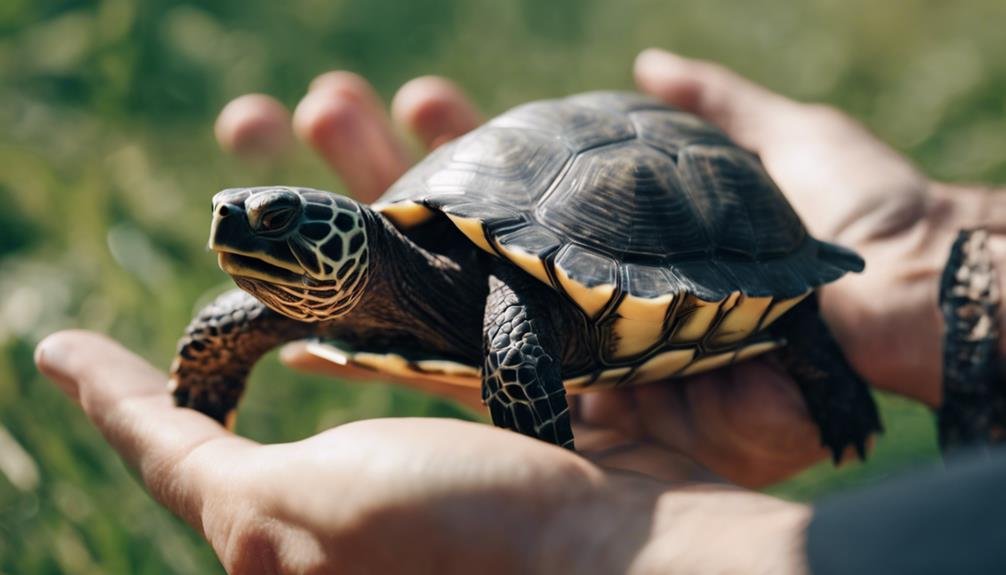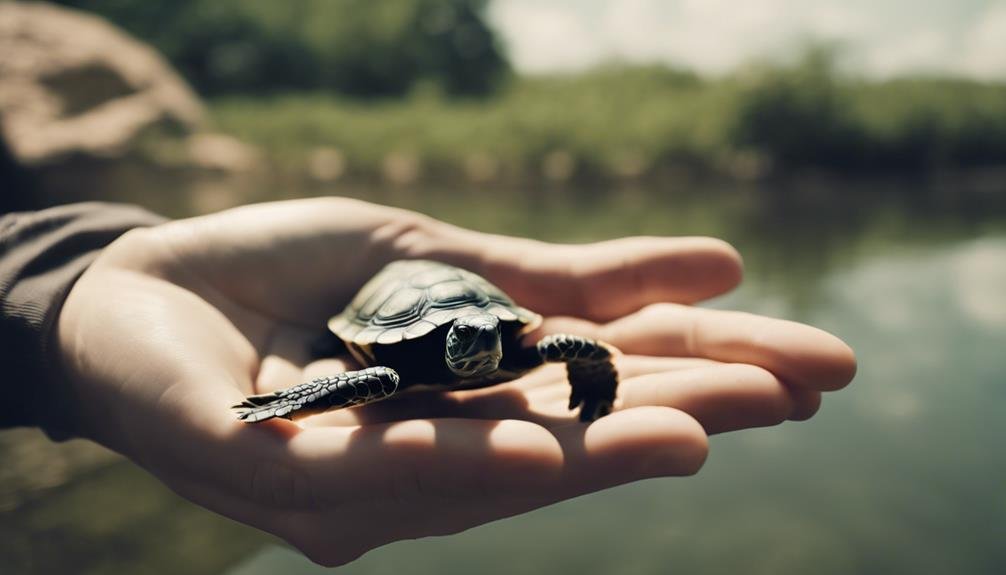Have you ever wondered if a turtle bite hurts? You’re not alone in pondering the strength behind those seemingly calm creatures. Turtles, equipped with sharp beaks and strong jaws, can indeed deliver a painful bite, depending on their species and size. But don’t let this intimidate you from interacting with them. By understanding their behavior and recognizing signs of aggression, you can greatly reduce your chances of a negative encounter. If you’re curious about how to safely handle these fascinating reptiles and prevent bites, you’ll find that a little knowledge and caution can make a big difference. So, what are the effective measures to ensure a friendly interaction? Stay tuned.
Key Takeaways
- Turtle bites can be painful due to their sharp beaks and strong jaws.
- The severity of a bite depends on the turtle’s size and species.
- Recognizing signs of stress and aggression in turtles can help avoid bites.
- Proper handling, such as lifting by the shell gently, reduces the likelihood of biting.
- Creating a safe and stress-free environment for turtles minimizes aggressive behavior.
Understanding Turtle Behavior
To effectively prevent turtle bites, it’s important to understand their behavior, as they often bite when feeling threatened or stressed. Recognizing the signs of discomfort in turtles can help you predict when a bite might be imminent, allowing you to adjust your actions accordingly. Turtle behavior is vital; they resort to biting primarily as a defense mechanism, not out of a desire to harm. By paying close attention to their body language, you’ll start to notice the subtle cues that indicate stress or fear.
Proper handling techniques are essential in minimizing the risk of a bite. When you’re gentle and consistent, you build trust and familiarity, which goes a long way in reducing aggressive behavior in your shelled friend. Remember, sudden movements or improper handling can easily stress a turtle, leading to a defensive bite.
Therefore, it’s not just about avoiding bites; it’s about creating an environment where your turtle feels safe and secure with you. This understanding and respect for their behavior and space lay the foundation for a harmonious relationship, where biting becomes less of a concern and more of an understandable reaction to fear or stress.
The Reality of Turtle Bites
Despite their often calm demeanor, turtle bites can indeed be quite painful, largely due to their sharp beaks and powerful jaws. The pain level and potential for injury depend greatly on the species and size of the turtle. Larger species, like snapping turtles, can inflict more serious wounds. Here’s a quick overview to help you grasp the impact of turtle bites based on size and species:
| Species/Size | Impact of Bite |
|---|---|
| Small Turtles | Minor pain, less likely to cause significant injury |
| Large Turtles (e.g., Snapping Turtles) | High pain level, potential for serious injury |
| Medium Turtles | Moderate pain, some risk of injury |
| Aggressive Species | Increased risk of pain and injury |
| Calm Species | Lower risk of pain, easier to handle safely |
Understanding turtle behavior and recognizing signs of aggression are key in avoiding bites. Proper handling techniques are essential for your safety and the turtle’s well-being. Always approach turtles with caution and respect their space. By being mindful of these factors, you can minimize the risk of injury and promote safe interactions with these fascinating creatures.
Creating a Safe Environment


Creating a safe environment for your turtles involves several key steps, including providing ample hiding spots and ensuring a spacious enclosure, to reduce stress and prevent aggression. Incorporating visual barriers within this space can also play a vital role in minimizing territorial disputes among your turtle residents. By creating an enriched environment, you’re not just giving them a place to live; you’re offering them a stimulating space that keeps them engaged and less likely to lash out.
Feeding turtles separately is another essential strategy. It prevents competition over food, which is a common trigger for aggressive behavior. This way, each turtle gets its fair share without feeling the need to fight for it.
Monitoring and adjusting the temperature and lighting within their habitat are also key to maintaining their well-being. Turtles thrive in environments that mimic their natural habitat, and getting this right can greatly reduce their stress levels.
Lastly, regular cleaning and maintaining the habitat are essential. A clean environment is a stress-free environment for turtles, helping to ward off any aggression-inducing discomfort. By keeping their living space in top condition, you’re ensuring they stay healthy and happy, making creating a safe environment a top priority in their care.
Signs of Stress in Turtles
Turtles show stress in several ways, including hiding more than usual and losing their appetite. If you notice your turtle spending more time tucked away or showing a lack of interest in food, it’s a clear sign they’re not feeling right. Unusual swimming patterns or aggressive behavior can also indicate they’re under stress. These behavioral changes are often a turtle’s way of communicating discomfort or anxiety.
Physical signs of stress shouldn’t be ignored either. Shell abnormalities, weight loss, and respiratory issues can manifest when a turtle isn’t in its best state of health. Such symptoms mightn’t only indicate stress but could also suggest underlying health problems that require attention.
The causes of stress can vary, but changes in environmental conditions and an inadequate diet are common culprits. Making sure your turtle’s habitat is well-maintained, with clean water and a balanced diet, is important for their well-being. If your turtle’s stress signs persist, seeking veterinary advice is necessary. A professional can help you identify the root of the problem, whether it’s environmental conditions or something else, and recommend solutions to ensure your turtle’s health and happiness.
Proper Handling Techniques


Understanding the correct way to handle a turtle is vital to prevent bites and guarantee both your safety and the well-being of your shelled friend. Handling techniques aren’t just about avoiding being bitten; they’re about respecting the turtle’s space and understanding its behavior.
When it’s time to pick up your turtle, remember these key points to ensure safety and prevent any mishaps:
- Approach from behind: Turtles can’t reach behind them very well, so approaching from the back minimizes your chances of getting bitten.
- Lift by the shell: Use a gentle grip on the sides of the shell, avoiding the tail, to lift your turtle. This method prevents stress and potential injury.
- Press gently on the rear end: Encouraging your turtle to retract into its shell can make handling safer for both of you.
- Be mindful of the nose: Turtles explore with their noses. Keep your fingers away from the front of their face to avoid curious bites.
- Understand their behavior: Recognizing when your turtle feels threatened can help you adjust your approach and handling techniques accordingly.
Preventive Measures and Tips
Understanding turtle behavior and identifying safe handling practices are key to avoiding painful bites.
You’ll also find that optimizing their environment plays an important role in minimizing stress and aggression in turtles.
These measures not only guarantee your safety but also contribute to the well-being of your shelled friend.
Identify Turtle Behavior
By observing a turtle’s body language, you can often predict and prevent potential bites. Turtles mightn’t communicate like people, but they certainly give away signs when they’re feeling threatened or are in another mood that might lead to biting. Keep an eye out for these behaviors, and you’ll not only keep yourself safe but also support the well-being of the turtle. Try to see things from their perspective and pay attention to their needs, like the need for space or protein-rich food, to understand their behavior better.
- Hissing sounds as a warning signal
- Rapid head movements indicating discomfort
- Retreating into their shell suddenly
- Aggressive positioning, like facing you directly
- Flattening their body as a defensive posture
Safe Handling Practices
Recognizing turtle behavior is key, and equally important is knowing how to safely handle these creatures to prevent bites. Incorporating essential handling techniques is vital.
When picking up a turtle, avoid the tail; instead, grasp the sides of the shell to prevent bites. Always avoid the mouth’s reach, as turtles may bite when feeling threatened. To minimize risk, approach turtles from behind, since they often examine objects with their nose and may react defensively if approached from the front.
Press down gently on the rear end to encourage them to retract into their shell, reducing the chance of a bite. Handle turtles with care and respect to ensure a positive interaction and prevent potential bites.
Environment Optimization
Establishing a perfect environment for your turtle not only enhances their well-being but also greatly reduces the likelihood of aggressive behavior leading to bites. By optimizing their living conditions, you’re addressing the root causes of stress and aggression, making your turtle happier and less inclined to bite. Consider these essential elements:
- Guarantee proper basking areas and hiding spots to reduce stress and aggression.
- Provide a varied and balanced diet to prevent food-driven aggression.
- Monitor and maintain water quality to avoid health-related aggression.
- Use visual barriers like plants to minimize territorial disputes.
- Regularly observe your turtle to catch early signs of stress or aggression.
Adopting these practices will help maintain a peaceful and safe environment for both you and your turtle.
>Can Preventing Turtle Bites Also Help Protect Against Diseases They Carry?
Preventing turtle bites is essential for reducing the risk of diseases carried by turtles. By avoiding physical contact with turtles, individuals can minimize the potential transmission of diseases such as salmonella. Proper hygiene and handwashing after handling turtles can further help protect against these diseases.
Frequently Asked Questions
How Do You Not Get Bit by a Turtle?
To avoid getting bitten by a turtle, approach it from behind and pick it up by the sides of its shell. This way, you’re out of its bite range.
Remember, turtles might bite if they’re scared or stressed, so stay calm to keep the situation from getting worse. Don’t put your hands near its mouth, and always respect its space.
What Do You Put on a Turtle Bite?
If you’ve been bitten by a turtle, you’ll want to follow a few steps to ensure proper care for the wound.
Clean the wound with mild soap and water first. Then, apply an antiseptic ointment to help it heal and cover it with a sterile bandage to keep it clean.
Keep an eye on the bite for any signs of infection, like redness, swelling, or pus. If it looks infected or you’re worried about it, don’t hesitate to see a doctor.
What if a Turtle Bites You?
If a turtle bites you, stay calm and wait for it to let go; don’t pull away. This might just be a warning bite, not an aggressive move. Keep still to avoid further upsetting the turtle, allowing it to retreat.
If the bite breaks your skin or hurts a lot, seek medical attention as turtles can carry bacteria leading to infection. Remember, abrupt movements can make things worse, so move back slowly instead.
Can a Turtle Bite You if You Pick It Up?
Yes, a turtle can bite you if you pick it up, especially if it feels threatened or startled. To minimize the risk, you should learn to handle turtles properly.
This means avoiding sudden movements and picking them up from angles that are less likely to provoke them. Additionally, understanding their behavior and body language can greatly reduce the chances of getting bitten.
Always approach turtles calmly and with care to prevent any negative reactions.
Conclusion
To wrap up, turtle bites can indeed be painful, but understanding their behavior and recognizing signs of aggression can greatly reduce your risk of being bitten. By creating a safe environment, paying attention to signs of stress, and handling turtles properly, you can guarantee a positive interaction.
Remember, it’s all about respect and caution. Follow these tips, and you’re less likely to experience the sharp end of a turtle’s beak. Stay informed, stay safe, and enjoy your time with these fascinating creatures.


